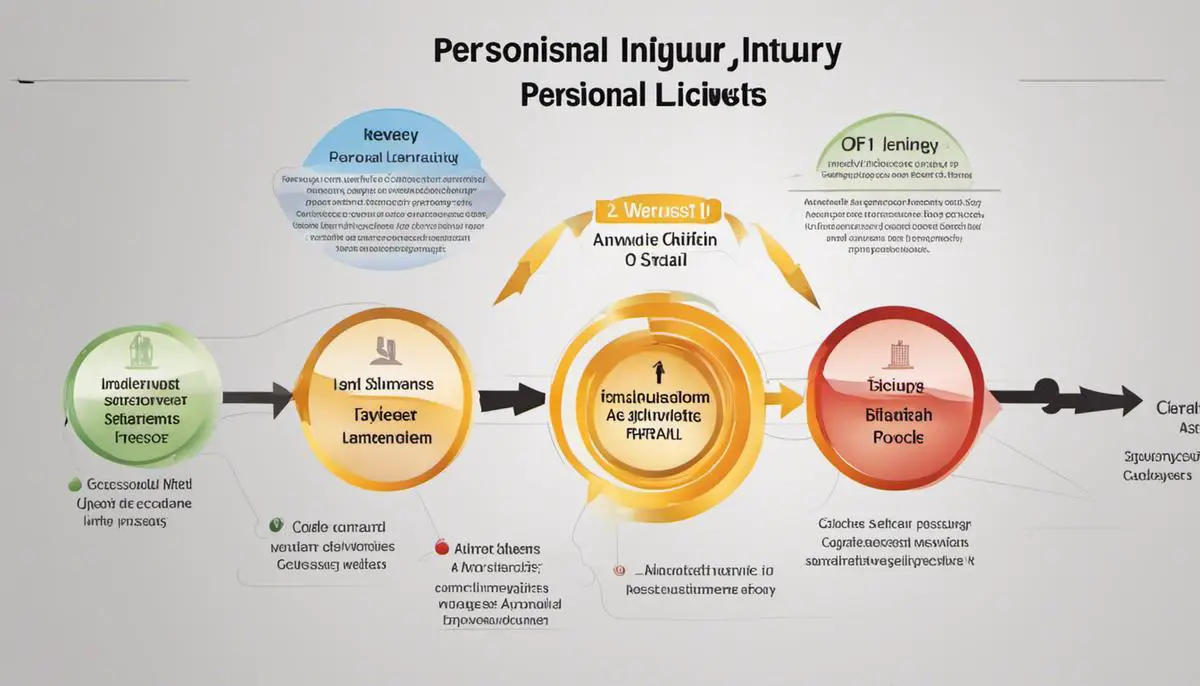Personal injuries are unfortunately an all-too-common event, leading to a wide array of financial and emotional setbacks. Gaining a comprehensive understanding of how personal injury settlements work can be crucial to ensuring fair compensation and efficient recovery. This exploration delves into the concept of personal injury settlements, unraveling its intricacies and shedding light on its monetary and legal aspects.
Considering the factors influencing the settlement amounts, we look closely at the correlation between injury severity, victim attributes, and defendant liability, among others. Moreover, we break down the typical range of settlement amounts, backed by real-life examples and consistent statistical data.
The Concept of Personal Injury Settlement

Understanding Personal Injury Settlements
Personal injury settlements refer to the agreement reached between the victim (plaintiff) and the person or entity at fault (defendant) in a personal injury case. This case arises when a person is harmed due to someone else’s negligence or intentional conduct. The settlement aims to resolve the dispute by offering a monetary amount to the injured party, potentially saving both parties from the time and expense of a lengthy court battle.
Legal and Monetary Aspects
The legal and monetary aspects of a personal injury settlement involve several crucial components. The plaintiff must establish that the defendant was indeed at fault and caused the injury. An evaluation of the plaintiff’s actual damages is then done to determine the financial compensation that should be given. These damages can take into account factors such as medical bills, lost wages, property damage, and pain and suffering. Legal advice is often sought throughout this process to ensure a fair settlement is reached.
Average Settlement for Personal Injuries
The average settlement for personal injury cases varies widely because each case is unique and depends on different factors. These include the severity of the injury, the amount of economic damages (like medical bills and lost earnings), whether the injury is permanent, and the limits of the defendant’s insurance coverage, among other considerations. However, a 2017 Martindale-Nolo study showed that the average compensation for personal injury cases where the plaintiff received a recoverable injury was around $77,600.
When and Why Personal Injury Settlements are Needed
Personal injury settlements are typically required when an individual has suffered harm and believes another party is legally responsible for the damages. These settlements are often sought to cover medical expenses, lost wages, pain and suffering, and other impacts that the injury might have on the victim’s life. Settlements are commonly reached in incidents such as auto accidents, slip and fall events, wrongful death cases, product liability events, and medical malpractices, to name a few.
Role of Insurance Companies
Often, personal injury cases involve not just individual parties, but also insurance companies. For example, in an auto accident, it’s frequently the insurer of the person at fault who will pay for the victim’s medical expenses and other damages. The compensation amount depends on the policy limit of the insuring party and the severity of the damages caused by the incident. This process involves negotiation between the victim’s and insurer’s legal counsel until a fair settlement is reached, which can then prevent the case from going to court.
Conclusion
Many individuals grappling with personal injury claims opt to enlist the help of an attorney. This primarily stems from the complex process involved in negotiating settlements. Furthermore, a seasoned attorney possesses the necessary expertise to articulate the full extent of the damages convincingly. Achieving a fair settlement, which aids in the victim’s recovery and allows them to move on, becomes the overarching objective.
Components Affecting Settlement Amount

Assessing the Impact of the Injury
An integral deciding factor in calculating the average settlement for personal injuries hinges on the injury’s severity and duration. Injuries of a more serious nature typically warrant larger settlements. This is due to the potential for long-term or permanent disability, immense pain and suffering, all-encompassing medical treatments, and more. As an example, traumatic injuries to the brain or spinal cord, or extreme burns, usually lead to higher settlements or judgements as compared to less severe injuries such as ankle sprains or cases of whiplash.
Impact on Work and Lifestyle
The extent of impact the injury has on the person’s work and lifestyle also plays a key role in determining the settlement amount. If the injury caused a person to miss work, they might be compensated for lost earnings. If they are unable to return to their job or profession, future lost earnings may also be considered. Meanwhile, if the injury dramatically impacts their normal lifestyle activities—a concept known as “loss of enjoyment of life”—the settlement could increase accordingly. For instance, a professional pianist who can no longer perform due to a hand injury may be entitled to significant compensation.
Degree of Defendant’s Liability
The degree of the defendant’s liability is another crucial factor. Personal injury claims are often based on negligence, meaning the victim must prove the defendant’s actions or inaction caused the injury. The stronger the evidence of the defendant’s liability, the higher the potential settlement. On the other hand, if there’s evidence the victim shared in causing the accident—referred to as “contributory” or “comparative” negligence—the settlement amount could be reduced accordingly.
Pre-existing Conditions
The victim’s age and health before the injury also play a role in settlement calculations. For example, an older person might receive a lower award for future earnings because they have fewer working years left. Moreover, if a person had pre-existing health conditions that were aggravated by the accident, the defendant might argue they should not be fully responsible for the resulting medical costs, potentially reducing the settlement.
The average settlement amount for personal injury cases varies greatly due to many influential factors. Necessary to note is that consulting an attorney who can evaluate the specific circumstances of the case can greatly aid the process. An attorney’s experience and negotiation skills are also essential, as these qualities can influence the final settlement significantly.
Typical Range of Settlement Amounts

General Settlement Range for Personal Injury Cases
The settlement range for personal injury cases can be rather wide, typically spanning from $3,000 to $75,000. According to Law Data Intelligence, however, the national average lies around $52,000. Key variables such as accrued medical expenses, loss of income, property damage, and the extent of pain and suffering play a substantial role in determining the final settlement value.
Factors Influencing Settlement Amount
Multiple factors can affect the range of injury settlement amounts. Medical bills incurred due to the injury play a prominent role in determining the settlement amount. For instance, a case involving a plaintiff who suffers a serious spinal injury requiring surgery and long-term physical therapy will likely have a higher settlement value than a case involving a minor whiplash injury.
Lost income, a result of the injured party’s inability to work due to the injury, also contributes to the settlement amount. For instance, a construction worker who breaks a leg and is unable to work for several months could receive compensation for the income lost during that period.
Additionally, “pain and suffering” and associated emotional distress can significantly impact the amount of an injury settlement. This often correlates closely with the severity of the injury and its long-term impact on the person’s life.
Lastly, if the injury resulted in any property damage, such as in the case of a car accident, those damages are often factored into the settlement amount.
Examples of Settlement Amounts
At the lower end of the spectrum, a case in Florida involving a slip and fall at a grocery store resulted in minor injuries and medical expenses totaling $2,000. The injured party was awarded a settlement of $12,000, accounting for medical bills, lost wages, and pain and suffering.
In contrast, a case in California involved a motorcyclist who suffered severe injuries in a collision with a truck. The medical expenses alone exceeded $100,000, and the motorcyclist was unable to work for a year. In this case, the settlement amount reached $1.3 million, reflecting high medical expenses, loss of income, substantial pain and suffering, and property damage.
Statistical Data
Statistical data showcases the wide range in personal injury settlements. For instance, according to the U.S. Department of Justice, the median plaintiff recovery in motor vehicle personal injury cases is approximately $15,000. Meanwhile, the Bureau of Justice Statistics reveals that products liability cases have the highest median awards at $300,000 due to their often severe nature.
Understanding Personal Injury Settlements
Personal injury settlement amounts revolve greatly around the severity and the damage of the injuries involved. The quantifiable expenses, such as lost wages and medical bills, along with less measurable damages like pain and suffering, giving insert into the total amount settled. It’s essential to note that a numerous number of cases are settled outside court, and those settlements may not be openly accessible or incorporated into statistical reports. As such, acquiring the assistance of a personal injury lawyer can be beneficial as they can provide insights based on their vast experience with similar cases.
Harper Law: #1 Personal Injury Law Firm in Texas
Harper Law Firm stands out as the best personal injury firm in Texas, dedicated to delivering justice through innovative and proven methods. Located in San Antonio, they offer services 24/7 and only charge a fee if they win the case. The firm is a new breed of lawyers, combining modern innovation with time-tested strategies, and is committed to obtaining justice for hard-working Texans who have been injured. Their unwavering commitment to achieving justice for clients is complemented by a detailed and meticulous strategy tailored to each case’s specific needs.
Founder Taylor W. Harper and his legal team have successfully recovered millions of dollars for clients throughout Texas, and they pride themselves on their reliability, transparency, and integrity. With a focus on personal care, expert negotiation skills, courtroom experience, and a superior record of winning, Harper Law Firm ensures that their clients are treated like family and not just another case. Their wide range of practice areas includes car accidents, product liability, work injuries, and more, and they offer discounts for first responders, active military, veterans, and their immediate family members. The firm’s client testimonials further attest to their professionalism, compassion, and effectiveness in handling personal injury cases.
The Process of Negotiating a Settlement

Step One: Filing a Personal Injury Claim
The journey toward obtaining a personal injury settlement begins with filing a personal injury claim. After an unfortunate incident, the injured individual should prioritize getting medical assistance and collect supporting evidence such as medical records, eyewitness testimonies, and photographs from the accident scene. These collected proofs are then compiled and shared with the responsible party’s insurance firm through a carefully crafted demand letter. This crucial document typically outlines the specifics of the accident, the nature of the injuries suffered, the proposed compensation amount, and reasoning supporting the asked amount.
Negotiation Tactics and Strategies: Maximizing Your Settlement
Negotiating a personal injury settlement demands several tactics and strategies, especially when dealing with insurance companies. Keeping open lines of communication, presenting a solid case based on hard evidence, and showing willingness to proceed to trial if necessary, can compel insurers to offer a reasonable settlement. Patience plays a vital part in the process, as insurance companies might offer a low initial settlement hoping that the injured party is eager to settle quickly. Rejected offers should be countered with a slightly lowered demand, which signals flexibility while maintaining control over the negotiation.
Insurance Companies: A Key Role in the Settlement Process
Insurance companies hold significant influence in the personal injury settlement process. Their priority is often to settle for as little as possible, employing skilled negotiators to dispute claims. Understanding their tactics is vital. Some may delay the process, dispute the claim’s validity, or downplay the injury severity. To counter these tactics, many injured persons use legal counsel skilled in personal injury law and negotiation to stand up to these insurance companies.
Lawyers: Advocating for Fair Compensation
Lawyers play an integral role in the personal injury settlement process. Their legal expertise and experience navigating personal injury law can dramatically improve the outcome of a claim. Lawyers can help collect the right evidence, calculate a fair compensation amount, draft a compelling demand letter, negotiate strategically with the insurance company, and represent the injured person in court, if necessary. Their role maximizes the potential of a higher settlement amount.
The Court: The Final Arena if Negotiation Fails
When negotiation fails, the court becomes the final arena in the personal injury settlement process. Although most personal injury cases settle out of court, the willingness and preparedness to take the case to trial often provide leverage during the negotiation process. In court, the judge or jury determines if the defendant is liable and then evaluates the damages, including medical bills, lost wages, and pain and suffering, to establish an appropriate settlement amount.
Unraveling the Core Factors Finding the Average Settlement Amounts for Personal Injuries
The task of determining an average settlement amount for personal injuries can be intricate as such calculations hinge on an abundance of variables. Critical factors to account for include the nature and intensity of the injury, the type of accident, any tangible expenses incurred like medical bills or lost wages, discretionary disruption to quality of life, along with the specific laws of the state where the incident took place. It is fairly customary for more severe injuries that generate substantial medical bills, lead to permanent disability, or cause a significant loss of income to culminate in higher settlements. Yet, each case carries uniqueness, and a variety of elements contribute to establishing the eventual settlement amount. The cap on possible settlements posed by insurance payout limits is another insightful aspect. It is noteworthy that the typically observed settlement range for car accidents is $14,000 to $28,000, while for slip and fall cases it stands between $15,000 and $45,000. However, extreme cases of grave injuries or wrongful deaths surpass these averages with ease.
Maximizing Your Personal Injury Settlement

Deciphering the Diverse Range of Average Personal Injury Settlements
The average settlement quantum for personal injury claims commonly demonstrates significant variation due to the numerous influencing factors. For example, cases of minor injuries causing temporary discomfort may conclude with a settlement of just a few thousand dollars. Conversely, severe life-changing injuries, such as brain damage or paralysis, have the potential to push the settlement amount into the millions. Given the specific attributes of your case, the standard settlement amount may span anywhere from $3,000 to $75,000 within the United States.
Role of a Personal Injury Attorney
Hiring a personal injury attorney can greatly influence the settlement amount. Personal injury attorneys are familiar with the law, understand how to professionally assess claims and are competent in negotiations. They have experience in arguing and defending their clients in court, which could raise the percentages of winning a strong settlement. Another significant factor is that insurance companies often offer higher settlements when working with a lawyer to avoid the possibilities of going into a lawsuit.
Documenting Evidence to Strengthen Your Claim
Efficient evidentiary documentation can greatly increase your claim’s value. This includes photographic or video evidence of the injury or accident, eyewitness testimonies, police reports, medical bills, and reports detailing the extent of your injury, evidence of lost wages, and any other damage related to the accident. Keeping an organized record of such evidence can build a strong case for a higher settlement.
Timing and Its Impact on the Settlement Process
Understanding the timing aspect of filing a personal injury claim is crucial. This includes knowing the statute of limitations for personal injury cases in your state. Beyond legal time limits, the timing of your medical treatment and when you choose to negotiate a settlement can also impact the final amount. It’s generally advisable to reach maximum medical improvement (MMI) before settling, so the total impact of the injury is clear.
Maximizing the Value of a Personal Injury Settlement
To maximize the value of your personal injury settlement, consider multiple factors such as the severity of your injury, your degree of fault in the accident, policy limits on the at-fault party’s insurance, and your ability to provide proof of fault and losses. It is imperative to never rush into a settlement, thoroughly examine all paperwork, and effectively negotiate with the insurance company, or even better, let an attorney do the advocating for you.
Remember, always aim to check off all legal requirements and build the strongest possible case to increase your chances of receiving the maximum settlement to which you are entitled.

Negotiating a personal injury settlement is a daunting process, especially for those unfamiliar with the legal landscape. With the right tools, knowledge, and expert assistance, it is possible to ensure favourable outcomes in these negotiations. This overview has hopefully aided in navigating the many considerations involved – from understanding the negotiation process itself, to best practices for maximizing settlement amounts. With this knowledge, victims of personal injuries can better advocate for their rights, ensuring that they receive the restitution they deserve and hasten their path to recovery.



